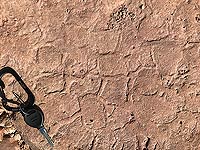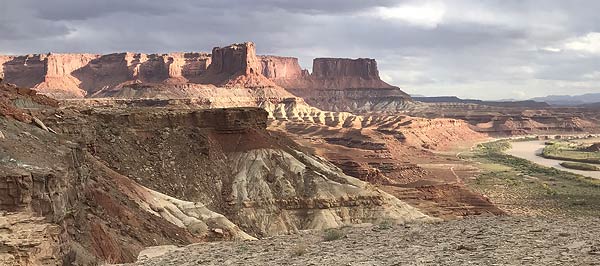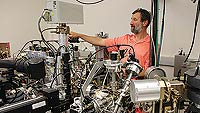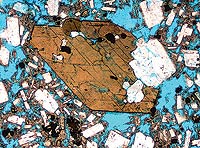GEOLOGY HAPPENINGS November 2021 |
| The Many Sciences of Geology By Allyson Mathis |
 |
| Mud cracks, such as these in the Morrison Formation, help sedimentologists understand the environments in which sedimentary rocks were deposited. |
Geology is the bedrock (pun intended) of understanding canyon country. Rock dominates southern Utah’s landscape. Exposures of bare rock make up cliff faces, canyon walls, and slickrock surfaces. Unconsolidated sediments (sand, silt, and gravel) are found along streams and dry washes, and in floodplains.
Geology is the study of the planet Earth. The Glossary of Geology elaborates: Geology includes the study of the materials that make up the Earth, the processes that act on these materials, and the history of the planet and its life forms.
Like all scientific endeavors, geology is dedicated to providing explanations of natural phenomena based using empirical data and natural processes. Geologists use facts (confirmed observations) to develop theories (explanations). Geology is largely a historical science, meaning that it deals with evidence from sequences of events and reconstructs histories by observing the evidence available for past events. Historical sciences do not exclude experimental sciences, but incorporate them as investigative techniques.
The Glossary of Geology definition makes it clear that geology is more than just “rock science.” In fact, the geosciences (a term roughly synonymous with geology) consist of many sciences. Some of the dozens of disciplines (e.g., paleontology, volcanology, and glaciology) are fairly well known, but others (such as geodesy) are not.
 |
| Labyrinth Canyon, Canyonlands National Park |
Most geologists have an area or two that they focus on (mine was igneous petrology, the study of igneous rocks), but most research is interdisciplinary. The full geologic story of any one area, such as around Moab, can only be discovered by multiple geoscientists researching different aspects of a region’s geology. This column explores just some of the Earth science disciplines that have revealed important parts of canyon country’s geologic stories.
Field Geology: Field geology consists of the observations of rock outcrops, sediments, other geologic materials, and landscape features in the natural environment. Fieldwork includes geologic mapping, measuring and describing rock units, prospecting for fossils, and collecting samples for laboratory analysis.
 |
| Geologist Matt Heizler in the Argon Geochronology Lab at New Mexico Tech. This dating technique uses the radioactive decay of an isotope of potassium and its half-life to determine when a rock crystallized. Image courtesy of New Mexico Bureau of Geology and Mineral Resources. |
While field geology is a fundamental aspect of many specific disciplines of geology, geologists need more scientific tools than rock hammers, good boots, and notebooks (or field computers). They use analytical techniques that can identify some elements at concentrations as low as parts per billion (i.e., 1 in 1,000,000,000), and can date when an event occurred hundreds of millions of years ago so accurately that it is known to within a few hundred thousand years (or less in rare cases).
Sedimentology and Sedimentary Petrology: These sciences focus on sedimentary rocks and the processes that form them. Petrologists study rocks under the microscope by slicing them, affixing them to slides, then polishing them so thin that light can pass through them. They also study the make up of the grains by using techniques such as x-ray diffraction. They crush samples to separate out unique crystals (zircons) that help identify the source areas of sedimentary rocks
Stratigraphy: Stratigraphers study rock layers (formations), their order, relative position, and how they vary from place to place.
Geomorphology: Geomorphology is the study of landforms, on scales ranging from an individual feature like a natural arch to entire landscapes like the Colorado Plateau.
Geochronology: Geochronology determines the age of rocks using features in them. Some techniques use the radiometric decay of radioactive isotopes, others determine how long a sediment has been buried, while additional ones calculate how long a rock at the surface has been exposed to cosmogenic radiation.
 |
| La Sal Mountains |
Paleontology: Paleontology is the study of ancient life. Paleontology itself incorporates several sciences ranging from anatomy and biology to stratigraphy, sedimentology, and geochronology.
Geodesy: Geodesy is the study of the size and shape of the Earth. One of the tools that geodesists use are high precision GPS devices that can measure the movement of tectonic plate relative to another one, movement that may occur at the rate of less than an inch (or cm) per year.
This list is just a small portion of the specialties that shed light on Moab’s geology. Other disciplines include tectonics, plate tectonics, structural geology, seismology, geophysics, mineralogy, economic geology, hydrology, geochemistry, and historical geology.
Research into any rock layer, landscape feature, or mineral deposit is usually involves several disciplines. Geology isn’t so much a single type of science, but a bunch of “-ologies.”
 |
| A photomicrograph (e.g., photo taken through a microscope) of a thin section of volcanic rock from Alaska. USGS photo. |
The origin and evolution of the Colorado River and its tributaries encompasses geomorphology, hydrology, geochronology, paleontology, igneous petrology, structural geology, tectonics, plate tectonics, and stratigraphy.
Research on the La Sal Mountains includes aspects of igneous petrology, geochemistry, mineralogy, tectonics, structural geology, stratigraphy, and glacial geology. Geologists have even figured out how to use certain types of crystals as geobarometers to determine the depth they crystallized at.
An understanding of the potash deposits in the Paradox Formation requires that geologists study stratigraphy, sedimentology, sedimentary petrology, mineralogy, geochemistry, paleontology, plate tectonics, tectonics, structural geology, and economic geology.
Regardless of what part of the planet that they study—whether rocks, fossils, faults, minerals, arches, rivers, or volcanoes—geologists share a passion for learning about Earth, its history, resources, hazards, and landscapes.
Why is the study of geology important? Because it helps us understand this planet that we call home. And more locally near Moab, it helps us understand the inspiring landscapes that surround us.